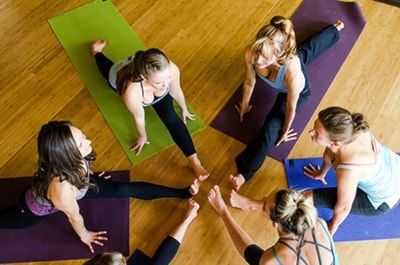Every day, new yoga mats unfurl under the well-toned, breath-centred bodies of Victoria’s yogis — but how much do these students really know about their instructors? Turns out, finding qualified teachers or becoming one yourself isn’t clear-cut.
Yoga certification in Canada is unregulated, but before you take to picketing, consider the benefits. Michelle Wilson, an administrator at the Canadian Yoga Alliance, says remaining deregulated is an ethical issue.
“We don’t want to see yoga become government or institutionally regulated because yoga is all about freedom,” she says. “It’s science, but it’s also a creative art form.”
Canadian Yoga Alliance offers a place for yoga teachers and schools to register their credentials. Like other governing bodies, it also offers advertising, insurance and wholesale products for those affiliated with the group. Wilson is quick to point out that Canadian Yoga Alliance and similar groups like Yoga Alliance, YogaBC and the International Yoga Federation are not legislatively empowered governing bodies. The standards offered by these groups amount to suggestion and there is variability between each of them.
The generally agreed upon standard for becoming a teacher is a 200-hour training course. To be qualified to teach that course requires an additional 1,000 hours of in-class teaching. All curriculums include understanding poses (asanas), anatomy, philosophy and classroom management.
There are three elements to consider in becoming a yoga teacher: type of yoga, cost of training and the time it will take.
If variety is the spice of life, yoga is very spicy. Vinyasas, Ashtanga, Jivamukti, Iyengar, Vinlyoga, Svaroopa, Bikram, Sivananda, Ananda, Kundalini, Kripalu, Anusara and Hatha are just a few authentic sounding variations. Yoga is a living discipline: styles change and are born through spontaneous discovery. This bendy profession is also heavily influenced by the cultures that assimilate it. Westernized versions include Power Yoga, Prenatal Yoga, Restorative (Meditative) Yoga and Cardio Yoga. Each one utilizes many of the same poses, making intimate understanding of each asana essential.
Cost can vary considerably. In Victoria, the basic standard is $2,000 to $2,600 for a 200-hour teacher-training course over several months. One course in Victoria is $5,000 for 700 hours. For Wilson, this level of discrepancy is problematic.
“Personally, I’d like to see standards for yoga training at a minimum of 500 hours with 3,000 teaching hours [to train teachers],” she says.
The number of days that 200-hour standard is compacted into also varies. Some intensive live-in programs can be completed in less than one month. Those taken over time can stretch anywhere from six months to three years.
Laura Phelps is the owner of Feel Good Yoga & Pilates and the director of its teacher training program here in Victoria. She is a 500-hour registered yoga therapist and senior yoga teacher with YogaBC. She also has certification through the Pilates Method Alliance. Her journey into yoga began with a devastating mercury poisoning diagnosis while in Sweden. Debilitating pain, immobility and a constant fear of the mercury moving to vital organs left Phelps in a deep depression. When doctors told her improvement was unlikely, she withdrew even more.
It was her husband who eventually coaxed her back into the world with tapes of the Chinese meditative martial art of Qigong. Through its breathing techniques and small movements, she enjoyed pain-free periods and much needed moments of hope. After working with a toxicologist in Florida, her newfound understanding of breath and the mind-body connection took to more fertile ground.
For Phelps, registering with these over-arching organizations is important for her profession. While over-regulation isn’t her goal, standards do exist in yoga whether they are supported by the government or not. For this reason, she suggests that all of her students register with an organization that best reflects the student’s high standards and particular needs. For most, registration fees make multiple affiliations cost prohibitive.
“These groups might not get it perfect every time. They have staff and time limitation like we all do,” says Phelps. “But they offer a valuable service and make sure teachers stay up to date with continued education courses (CEC). CECs need to be completed every two years along with initial requirements.”
James Hayter, president of YogaBC, says concerns about groups like his have been echoed throughout the province. “It’s important that we [yoga practitioners] are all a part of the conversation around yoga standards,” Hayter says. “Also, yoga can’t be viewed as a standalone science. It must be viewed as part of the Ayurvedic sciences [5,000-year-old medical tradition].”
Phelps admits there have been times when unqualified schools and teachers become registered with one or more of the governing bodies. Keeping them aware of those discrepancies is part of being a responsible participant in the yoga profession.
These are also internationally recognized brands, particularly the Yoga Alliance in the U.S., so affiliation can be very helpful in establishing work abroad.
“You can teach anywhere in the world if you register with them,” Phelps says. “People know they have high standards.”
Phelps has 20-30 graduates per year and says the market still isn’t saturated. Between different recreation clubs, yoga studios on every corner and even chiropractors offering yoga services, the work is out there.
When considering yoga as your new profession, Phelps also says there are a few things to be mindful of. “Some people are more afraid of public speaking than death. That’s a fact. Some don’t realize teaching yoga is public speaking along with all the other elements. It’s something to consider,” she says. “People move to Victoria to be healthy. We’re choosing lifestyle despite the high living costs and housing prices. Yoga fits in nicely!” M
